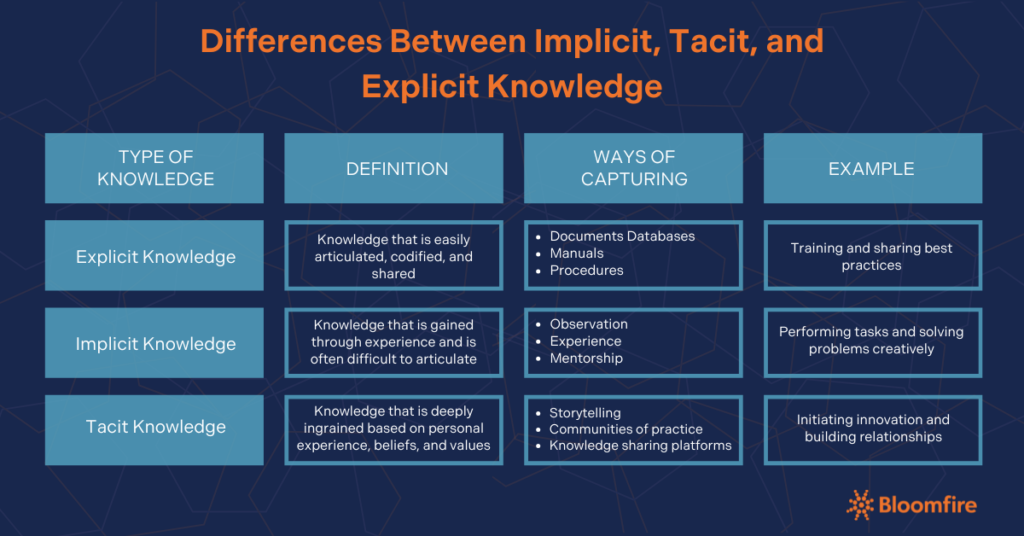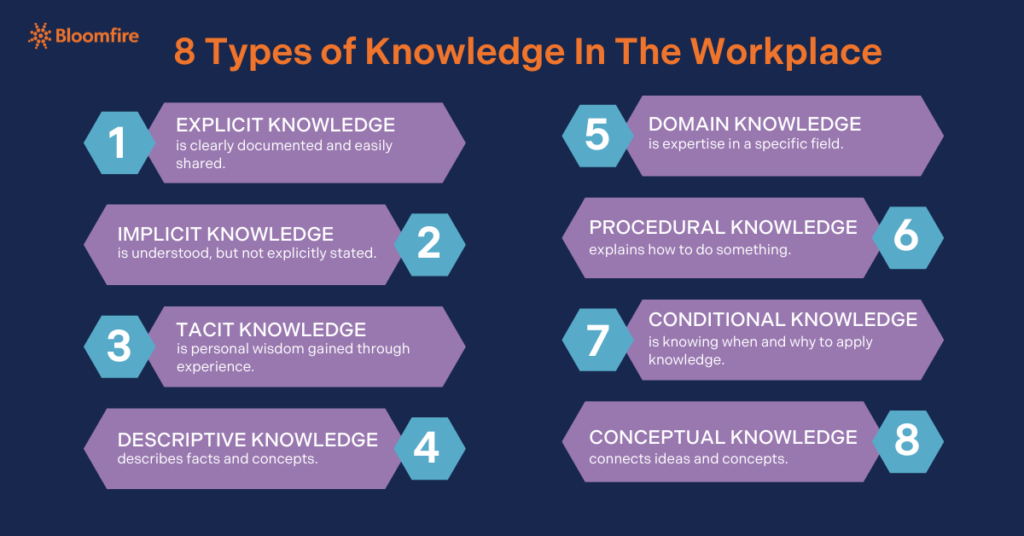Different Types of Knowledge: Implicit, Tacit, and Explicit

Quick Definitions of Knowledge Types for Business
Explicit Knowledge: Knowledge that is easy to articulate, write down, and share.
Implicit Knowledge: The application of explicit knowledge. Skills that are transferable from one job to another are one example of implicit knowledge.
Tacit Knowledge: Knowledge gained from personal experience that is more difficult to express.
When researching knowledge management, you may encounter discussions about the various types of knowledge. While many classifications exist, businesses prioritize understanding and leveraging three key types: tacit, implicit, and explicit knowledge. These distinct forms of knowledge are crucial for organizational success because they provide tailored data assets.
A robust knowledge management strategy begins with recognizing the differences between these three types of knowledge and effectively capturing, maintaining, and sharing each one. Below, we explain the key criteria for this distinction, other types of knowledge, and the challenges of extracting each.
Tacit, Explicit, and Implicit Knowledge: Value and Differences
The key difference between tacit, explicit, and implicit knowledge is the process of capturing and utilizing them across the business landscape.
Explicit knowledge, for instance, is documented and can be easily shared. It is often used to train new employees and to ensure that everyone has the same understanding of how to do their job.
Conversely, implicit knowledge is shared between employees through social interactions and informal communication. Although it is often the most challenging type of knowledge to capture and share, it is essential to ensure that knowledge is passed on from one generation of employees to the next.
Tacit knowledge, acquired through experience, can be difficult to articulate. However, it is often the most valuable type of knowledge in a business, as it allows employees to make decisions and solve problems quickly and effectively.
If you’re conducting a knowledge audit (a significant first step for any knowledge management strategy), it’s crucial to understand how these types of knowledge are defined and structured.

Capture All Types of Knowledge
Use Bloomfire’s advanced tools to obtain and preserve valuable company knowledge.
Explore Bloomfire
What Is Explicit Knowledge?
Explicit knowledge is the most basic form of knowledge and is easy to pass along because it’s written down and accessible. When data is processed, organized, structured, and interpreted, the result is explicit knowledge. Explicit knowledge is easily articulated, recorded, communicated, and stored (most notably in knowledge management).
Examples of Explicit Knowledge
If you need an example of explicit knowledge, simply open your knowledge management platform and look around. Specifically, it may encompass the following:
- Company policies
- Process documents
- Employee handbook
- Training manuals
- Case studies
- Knowledge base
- White papers
- Technical documentation
- Research reports
Did You Know? Advancements in technologies like artificial intelligence (AI), machine learning (ML), and natural language processing (NLP) are making it easier to capture, organize, and share explicit knowledge within organizations. AI applications have enhanced knowledge management by making explicit knowledge more accessible to departments.
What Is Implicit Knowledge?
Implicit knowledge is the practical application of explicit knowledge. There are likely instances of implicit knowledge all around your organization. For example, consider asking a team member how to perform a task. This action could spark a conversation about the options for performing the task and the potential outcomes, leading to a thoughtful process to determine the best course of action. That team member’s implicit knowledge educates the conversation about how to do something and what could happen.
Examples of Implicit Knowledge
Best practices and skills transferable from job to job are some of the common examples of implicit knowledge. In particular, these may cover:
- Executing negotiation techniques
- Delivering effective sales pitches
- Approaches to conflict resolution
- Quick decision-making skills
- Absorbing organizational culture
What Is Tacit Knowledge?
Tacit knowledge is the knowledge we possess garnered from personal experience and context. It’s the information or data that would be the most difficult to write down, articulate, or present in a tangible form.
For example, think of learning how to make your grandmother’s famous cookie recipe. Sure, she gave you the recipe card, but when you try it, you feel like something is missing. After years of experience, she has learned the exact feel for the dough or how long the cookies should be in the oven.
Examples of Tacit Knowledge
In the workplace, tacit knowledge is the application of implicit knowledge specific to your company. As employees move from job to job, the application of their implicit knowledge will change based on what’s unique about your business. An example is a sales rep who can give a great demo and has also learned specific buying signs while talking to prospects.
Here are some other examples of tacit knowledge in the workplace:
- Intuitive understanding of motivating teams
- Closing sales using innate capabilities
- Understanding the nuances of human interaction
- Overcoming sales objections
- Generating groundbreaking ideas or innovative solutions
Transfer of tacit knowledge may not necessarily follow a structured process. According to a study published in the Journal of Workplace Learning, professionals must find ways to make their tacit knowledge explicit and share it with others. This can be done through reflection, stories, and other forms of communication.
Other Types of Knowledge
Aside from explicit, implicit, and tacit, knowledge can be classified in other ways based on its nature and purpose. In some cases, these types of knowledge may overlap. However, it is up to the knowledge manager and those in charge of the knowledge management maintenance to choose a way of distinguishing knowledge. For added guidance, here are the other types of knowledge in the workplace.
- Descriptive knowledge refers to understanding how things are or how they work, essentially describing the characteristics of a concept or process. For example, it is essential to know the company’s organizational structure, including the different departments and their functions, or to understand the steps involved in a manufacturing process.
- Domain knowledge is the specialized understanding and subject matter expertise within a specific field or industry. For instance, a software engineer possesses domain knowledge in programming languages, software development methodologies, and cybersecurity best practices.
- Procedural knowledge focuses on how to do something, often expressed as steps or a sequence of actions. For example, a network engineer would know how to troubleshoot a network connectivity issue by checking cable connections and testing network connectivity using ping commands.
- Conditional knowledge is knowing when and why to use specific information or skills. For example, a customer service representative might use their knowledge of de-escalation techniques conditionally, applying them only when a customer shows signs of anger or frustration.
- Conceptual knowledge is the understanding of underlying principles, ideas, and relationships that connect different pieces of information. An example of this is a manager understanding the concept of employee engagement in customer service and how it connects to various factors like recognition, growth opportunities, and work-life balance.

The Challenges of Capturing the Different Types of Knowledge
Ultimately, no matter how company knowledge is defined, it plays a vital role in an organization’s day-to-day operations. However, to develop a successful knowledge management strategy, you must understand how different knowledge types are shared and stored. This is easier said than done, considering the following challenges.
1. Use of Wrong Technology for Knowledge Extraction
Many organizations mistakenly address knowledge-sharing problems by focusing solely on explicit knowledge, often implementing intranets or folder-based systems. These solutions fail to capture the crucial context and discussions surrounding that information, as questions and collaboration remain siloed in chats, emails, and informal interactions.
This problem with inappropriate tool or technology usage is amplified for remote teams. While they have access to explicit knowledge, they may struggle to tap into the implicit and tacit knowledge of the subject matter experts, hindering a comprehensive understanding.Power Move: Capturing implicit and tacit knowledge may seem challenging, but a modern knowledge management platform like Bloomfire offers tools to help subject matter experts preserve knowledge in all its formats.
2. Lack of Knowledge-Sharing Culture
When individuals are not encouraged or incentivized to share their expertise, tacit knowledge becomes trapped within individuals and teams, and explicit knowledge may not be readily accessible or disseminated. This can lead to knowledge or information silos, duplicated efforts, missed learning opportunities, and, ultimately, a less informed and effective organization.
Without a culture that values and promotes knowledge sharing, organizations risk losing valuable knowledge when employees leave. They may also struggle to adapt and innovate in response to new challenges and opportunities.
3. Problems With Keeping Knowledge Updated
Outdated information (including data decay for AI strategies) can lead to inaccurate or incomplete knowledge capture. The diverse formats of knowledge available can further complicate this.
Explicit knowledge may be easier to update through revisions, but tacit knowledge, residing within individuals, requires continuous observation and interaction to capture changes. Additionally, knowledge can be subjective and context-dependent, making it difficult to establish a single correct version to update. These factors collectively hinder the effective capture and maintenance of up-to-date knowledge.
4. Lack of Clear Process for Capturing Knowledge
Without a standardized system, some knowledge may be lost when employees leave. For example, tacit knowledge may not be recovered in such cases as there is no structured way to document or share it. Meanwhile, explicit knowledge can become scattered across various platforms and formats, making it difficult to find and retrieve.
Moreover, the absence of a defined process can lead to inconsistencies in how knowledge is captured, organized, and shared. This could create confusion and hinder knowledge transfer within the organization.
Collect Implicit, Tacit, and Explicit Knowledge Through Bloomfire
Bloomfire makes it easy for users to create content, add rich media for additional context, and find anything (not just document titles) through a keyword search. Additionally, users can engage with knowledge on the platform by asking questions, adding comments, or even tagging subject matter experts so that they are notified when they are mentioned.
Bloomfire also has direct integrations with Slack and Microsoft Teams, so the valuable knowledge that team members exchange in chat conversations can become part of their company’s knowledge base—and team members can easily access existing knowledge in real time.
Note: This post was expanded and updated in February 2025.
An All-in-One Knowledge Management Solution!
Bloomfire offers a range of tools to capture, share, and improve knowledge in your organization.
Schedule a Demo

Enterprise AI Search: Definition, Benefits, and Evolution

The Benefit of Company-Wide Knowledge Management in 2026

Are You Making These Common Knowledge Sharing Mistakes?

Estimate the Value of Your Knowledge Assets
Use this calculator to see how enterprise intelligence can impact your bottom line. Choose areas of focus, and see tailored calculations that will give you a tangible ROI.

Take a self guided Tour
See Bloomfire in action across several potential configurations. Imagine the potential of your team when they stop searching and start finding critical knowledge.